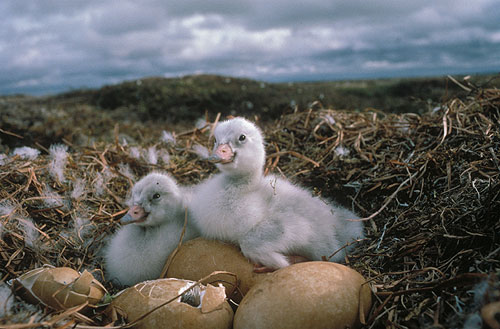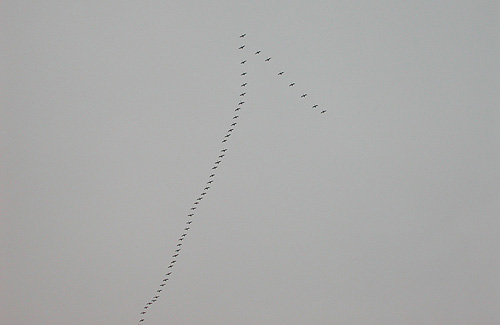 See you in Saskatchewan, said
the swan
See you in Saskatchewan, said
the swan
By NED ROZELL
November 05, 2008
Wednesday
A couple of weeks ago, at a time I assumed most migrating birds
were long gone, a flock of swans flew overhead in a formation
that resembled a check-mark headed out of Alaska. As the birds
silently wafted out of sight, I wondered where they might be
headed.
Not long after that, a biologist emailed me to show the results
of his summer work-the migration paths of about 50 tundra swans
he and his coworkers had fitted with satellite transmitters.
Looking at their progress now on Google Earth, I can see that
a swan took off from the pothole lake country southeast of Selawik
in early October, flew over my vantage point in Fairbanks on
October 6th, took a hard right through North Pole and continued
down a path roughly above the Alaska Highway. Around Calgary,
the bird made a run east to a huge reservoir in Saskatchewan
farm country. From there, the bird turned around and made its
way to where it now stands, or maybe floats, in early November:
a circle-pivot irrigated field near Dairy, Oregon.
 Cygnets, the chicks
of a tundra swan, born in western Alaska in summer 2008.
Cygnets, the chicks
of a tundra swan, born in western Alaska in summer 2008.
Photo by Craig Ely.
Though the bird with the transmitter flew over one day before
I noticed the group of swans, it's a good bet it was coming from
the same place. Craig Ely, a waterfowl biologist with the U.S.G.S.
Alaska Science Center in Anchorage, said that tundra swans are
gregarious enough that birds spending summer in the same place
often follow similar flight paths when they migrate in and out.
This fall and perhaps into fall 2009, Ely and his colleagues
are following 48 tundra swans with precision he never dreamed
of when he started studying swans 20 years ago.
During July and August of summer 2008, biologists went to five
different regions where tundra swans hang for the summer and
hatch brand-new cygnets-near Cold Bay, King Salmon, the Yukon-Kuskokwim
delta, Kotzebue Sound, and the mouth of the Colville River on
Alaska's North Slope. With dip nets and other tools, the biologists
captured the temporarily flightless birds (because they were
molting-replacing some flight feathers) and surgically implanted
satellite transmitters in the abdomens of 10 birds at each location.
The transmitters are less obtrusive to the birds than those wrapped
around the neck or worn as a backpack, Ely said, and they should
be good for two years, which will at least allow biologists to
track next spring's migration back to Alaska.
 Swans migrating over
Fairbanks, Alaska in October.
Swans migrating over
Fairbanks, Alaska in October.
Photo by Ned Rozell.
As for the fall migration, Ely learned that tundra swans around
Cold Bay don't migrate out of Alaska, as some biologists thought;
that some King Salmon birds migrating to California go all the
way inland to Saskatchewan during the trip; and that Colville
River swans, known to spend winters on the East Coast of the
U.S., also visit Saskatchewan before taking a hard left through
North Dakota and heading east.
"There must be good habitat in Saskatchewan, or else why
would birds going to (both the east and west coasts) make a big,
looping migration to go there on the way?" Ely said.
By following the birds he tagged
this summer, Ely has learned many things he didn't know, especially
the swans' use of remote habitats at northern staging areas before
migration and some details about swan migration biologists had
only guessed at before.
"This validates a lot of the data that's already in textbooks,"
he said.
Tracking the birds on the Internet is also a bit of fun for people
who want to follow the last birds to leave Alaska and the first
to arrive back next spring, which seems like a long time from
now. (alaska.usgs.gov/science/biology/avian_influenza/TUSW/index.html)
"Hopefully most of the (transmitters) will work through
the winter, and their approach will be a reminder that spring
is on the way," Ely said.
This column is provided
as a public service by the Geophysical
Institute,
University of Alaska Fairbanks, in cooperation with the UAF
research community.
Ned Rozell [nrozell@gi.alaska.edu] is a science writer at the institute.
E-mail your news &
photos to editor@sitnews.us
Publish A Letter in SitNews Read Letters/Opinions
Contact the Editor
SitNews
©2008
Stories In The News
Ketchikan, Alaska
|


